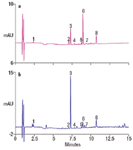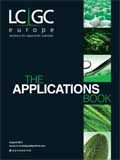Fast Determination of Catechins in Tea
Dionex Application note
Tea, one of the most consumed non-alcoholic drinks worldwide, contains catechins that are powerful antioxidants thought to provide many health benefits, including reduction of cholesterol and obesity, and protection against cardiovascular disease and cancer. The four major varieties of teas (white, green, oolong and black) are derived from the same Camellia sinensis plant, but as they are prepared by different processing methods, their catechin concentrations can vary. Thus, it is important to establish a simple and reliable analytical method to determine catechin concentrations in different tea products.
The most abundant catechins in tea include catechin (C), epicatechin (EC), epigallocatechin (EGC), epicatechin gallate (ECG), gallocatechin (GC), gallocatechin gallate (GCG) and epigallocatechin gallate (EGCG). The method described here uses a high-resolution Dionex Acclaim C18 RSLC column to separate and an absorbance of 280 nm to detect and quantify catechins in green and black teas in less than 20 min per injection.
Experimental
A Dionex UltiMate 3000 Rapid Separation LC (RSLC) system was used; for system components and preparation of solutions, please refer to Dionex Application Note 275 (1).
Results and Discussion
Figure 1(a) shows the catechins present in a commercially available green tea. The most abundant catechin in this green tea is EGCG, which is about 50% of the total catechin content, at 135.4 mg/g.

Figure 1
Figure 1(b) shows an analysis of black tea, where, unlike green tea, the EGC concentration is higher than the EGCG content and the total catechin content is 63.3 mg/g, nearly 50% less than that of the green tea. The caffeine levels are also higher in black tea as compared to green tea. Both the lower total catechin concentration and the higher caffeine concentrations are consistent with the increased processing of black tea. To evaluate method accuracy, the teas were spiked with known amounts of the seven catechins. Recoveries ranged from 90.2% to 102.3%, suggesting method accuracy. An accurate analysis of these complex samples requires less than 20 min per injection.
References
1. Dionex Corporation. Determination of Catechins in Tea; Application Note 275, LPN 2799: Sunnyvale, California, USA.
UltiMate and Acclaim are registered trademarks of Dionex Corporation.

Dionex Corporation
1228 Titan Way, PO Box 3603, Sunnyvale, California 94088, USA
tel: +1 408 737 0700 fax: +1 408 730 9403
Website: www.dionex.com

Analytical Challenges in Measuring Migration from Food Contact Materials
November 2nd 2015Food contact materials contain low molecular weight additives and processing aids which can migrate into foods leading to trace levels of contamination. Food safety is ensured through regulations, comprising compositional controls and migration limits, which present a significant analytical challenge to the food industry to ensure compliance and demonstrate due diligence. Of the various analytical approaches, LC-MS/MS has proved to be an essential tool in monitoring migration of target compounds into foods, and more sophisticated approaches such as LC-high resolution MS (Orbitrap) are being increasingly used for untargeted analysis to monitor non-intentionally added substances. This podcast will provide an overview to this area, illustrated with various applications showing current approaches being employed.
















